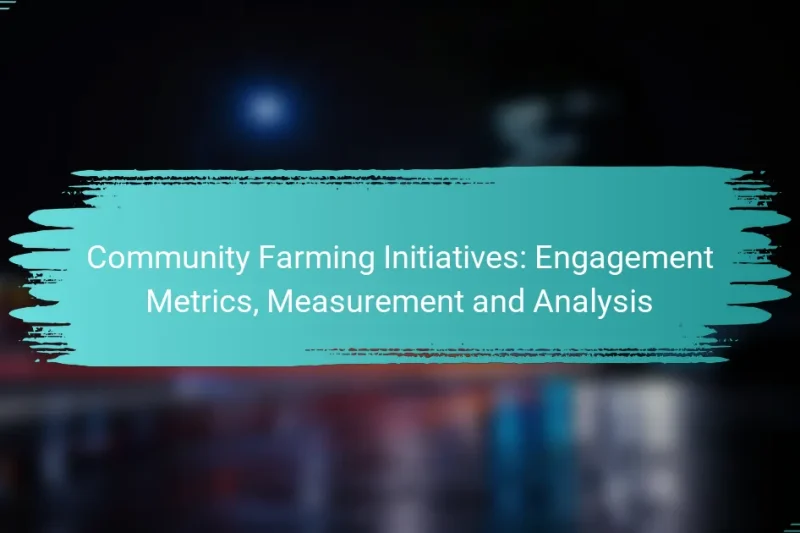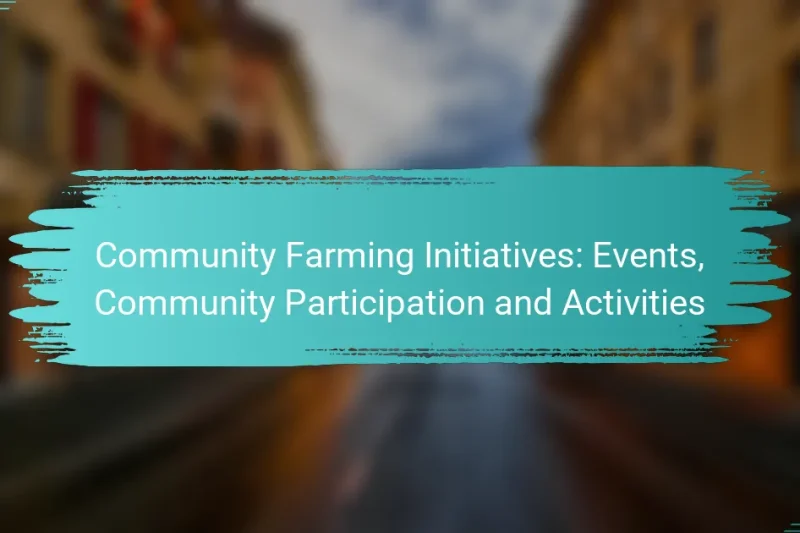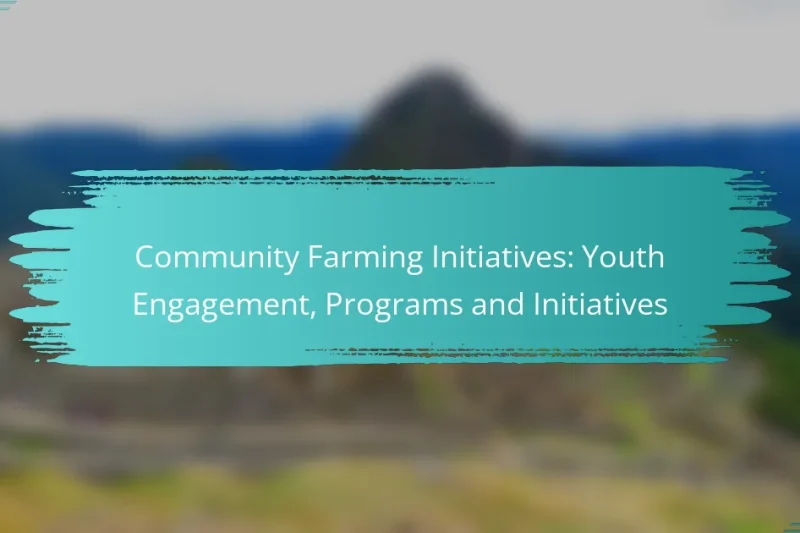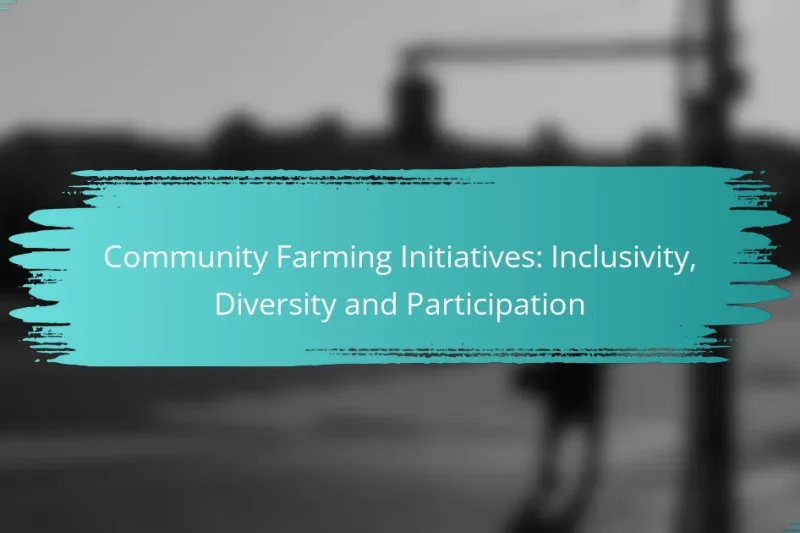Community farming initiatives play a crucial role in enhancing local engagement by promoting active participation and … Community Farming Initiatives: Engagement Metrics, Measurement and AnalysisRead more
Engaging Your Community in Farming
Engaging your community in farming is essential for fostering strong connections between local farmers and consumers. By implementing community-supported agriculture (CSA) and interactive methods such as workshops and farm tours, you can create opportunities for participation and learning. Additionally, leveraging technology can enhance communication and collaboration, ultimately strengthening the agricultural community and improving practices.
Community Farming Initiatives: Events, Community Participation and Activities
Community farming initiatives play a vital role in enhancing local food security by providing access to … Community Farming Initiatives: Events, Community Participation and ActivitiesRead more
Community Farming Initiatives: Youth Engagement, Programs and Initiatives
Community farming initiatives offer youth a unique opportunity to engage in hands-on agricultural activities that promote … Community Farming Initiatives: Youth Engagement, Programs and InitiativesRead more
Community Farming Initiatives: Volunteer Engagement, Strategy Development and Impact
Community farming initiatives play a vital role in enhancing local communities by promoting food access, environmental … Community Farming Initiatives: Volunteer Engagement, Strategy Development and ImpactRead more
Community Farming Initiatives: Inclusivity, Diversity and Participation
Community farming initiatives play a vital role in promoting inclusivity and diversity by engaging individuals from … Community Farming Initiatives: Inclusivity, Diversity and ParticipationRead more
Community Farming Initiatives: Social Media, Promotion and Engagement
Community farming initiatives can thrive through the strategic use of social media, which enhances awareness and … Community Farming Initiatives: Social Media, Promotion and EngagementRead more
Community Farming Initiatives: Partnerships, Local Businesses and Support
Community farming initiatives play a vital role in enhancing food security and fostering stronger connections among … Community Farming Initiatives: Partnerships, Local Businesses and SupportRead more
How can community-supported agriculture enhance local farming?
Community-supported agriculture (CSA) enhances local farming by creating a direct connection between consumers and farmers. This model allows community members to invest in local farms, ensuring a steady income for farmers while providing fresh produce to the community.
Increased local engagement
Community-supported agriculture fosters increased local engagement by encouraging residents to participate actively in their food systems. Members often visit farms, attend events, and volunteer, which strengthens community ties and promotes a shared commitment to sustainable practices.
Engagement can take various forms, such as farm tours, workshops, and seasonal festivals. These activities not only build relationships but also raise awareness about agricultural issues and the importance of supporting local food systems.
Access to fresh produce
CSAs provide members with direct access to fresh, seasonal produce, often harvested just hours before distribution. This ensures that consumers receive high-quality fruits and vegetables, which can significantly enhance their diets.
Typically, members receive a weekly or bi-weekly box of produce, which may include a variety of items based on the season. This model encourages families to try new foods and recipes, promoting healthier eating habits.
Support for local farmers
By joining a CSA, community members provide essential financial support to local farmers. This model allows farmers to receive upfront payments, which can help cover costs for seeds, equipment, and labor, reducing financial uncertainty.
Supporting local farmers also contributes to the local economy, as these funds are often reinvested in the community. This creates a cycle of support that benefits everyone involved, from producers to consumers.
Educational opportunities
CSAs often serve as platforms for educational opportunities related to agriculture, nutrition, and sustainability. Many farms offer workshops, cooking classes, and farm-to-table events that teach members about food production and preparation.
These educational initiatives can empower community members to make informed choices about their food and encourage sustainable practices in their own lives. Additionally, children involved in CSAs can learn valuable lessons about where their food comes from and the importance of supporting local agriculture.
What are effective ways to involve community members in farming?
Engaging community members in farming can be achieved through various interactive methods that foster participation and learning. Effective strategies include organizing workshops, establishing volunteer programs, and hosting farm tours and events that cater to different interests and skill levels.
Workshops and training sessions
Workshops and training sessions provide hands-on learning experiences that can attract community members interested in agriculture. These can cover topics such as organic farming techniques, pest management, or sustainable practices. Aim for sessions that last a few hours to a full day, allowing participants to gain practical skills.
Consider collaborating with local agricultural experts or universities to enhance the credibility and appeal of your workshops. Offering materials or refreshments can also increase attendance and engagement.
Volunteer programs
Volunteer programs are an excellent way to involve community members directly in farming activities. These programs can range from one-time events, like planting days, to ongoing commitments where volunteers help with daily farm tasks. Ensure you provide clear expectations and training for volunteers to maximize their contributions.
To attract volunteers, promote the benefits of participation, such as skill development, social interaction, and the satisfaction of contributing to local food systems. Offering incentives, like produce shares or recognition events, can also enhance volunteer retention.
Farm tours and events
Farm tours and events allow community members to experience farming firsthand and learn about agricultural practices. Organizing seasonal open days or themed tours can draw in families and individuals curious about local farming. These events can include guided tours, demonstrations, and opportunities to purchase fresh produce.
Promote these events through local schools, community centers, and social media to reach a broader audience. Consider charging a nominal fee to cover costs while still making it accessible, and ensure that activities are engaging for all age groups to encourage participation.
How can technology facilitate community engagement in farming?
Technology enhances community engagement in farming by providing tools that streamline communication, share information, and foster collaboration among farmers and local residents. These tools can help build a stronger sense of community and improve agricultural practices through shared knowledge and resources.
Mobile apps for farm updates
Mobile apps serve as effective platforms for sharing real-time updates about farm activities, weather conditions, and market prices. Farmers can use these applications to inform the community about crop availability, upcoming events, or changes in farming practices.
Examples of popular mobile apps include FarmLogs and AgriWebb, which allow users to track farm operations and communicate directly with community members. Ensuring that the app is user-friendly and accessible to all community members is crucial for maximizing engagement.
Online platforms for community discussions
Online platforms like forums and dedicated websites provide spaces for community members to discuss farming-related topics, share experiences, and seek advice. These platforms can facilitate knowledge exchange and help build relationships among farmers and local residents.
Consider using platforms like Facebook Groups or specialized agricultural forums to create a sense of belonging. Regularly scheduled discussions or Q&A sessions can further encourage participation and keep the community engaged.
Social media campaigns
Social media campaigns can effectively raise awareness about local farming initiatives and engage the community in various activities. By sharing stories, photos, and videos, farmers can showcase their work and invite community members to participate in events or volunteer opportunities.
Utilizing platforms like Instagram and Twitter allows for quick dissemination of information and can attract a wider audience. It’s essential to maintain a consistent posting schedule and interact with followers to foster a vibrant online community.
What are the benefits of urban farming initiatives?
Urban farming initiatives offer numerous advantages, including enhanced food security, improved community aesthetics, and a reduced carbon footprint. These initiatives empower local residents to grow their own food, beautify neighborhoods, and contribute to environmental sustainability.
Improved food security
Urban farming directly addresses food security by providing fresh produce to local communities. This is particularly vital in urban areas where access to healthy food options may be limited. By cultivating food within city limits, residents can reduce reliance on distant supply chains and ensure a steady supply of nutritious options.
Community gardens and rooftop farms can significantly increase the availability of fruits and vegetables, often leading to lower prices compared to grocery stores. Engaging local residents in these initiatives fosters a sense of ownership and responsibility towards food sources.
Community beautification
Urban farming enhances community aesthetics by transforming vacant lots and underutilized spaces into vibrant green areas. These farms not only provide food but also create inviting environments for residents and visitors alike. Well-maintained gardens can serve as focal points for community gatherings and events.
Incorporating flowers and ornamental plants alongside edible crops can further enhance the visual appeal. Community involvement in maintaining these spaces encourages pride and fosters stronger neighborhood connections.
Reduction of carbon footprint
Urban farming contributes to a lower carbon footprint by minimizing the distance food travels from farm to table. This reduction in transportation emissions is crucial in combating climate change. Additionally, urban farms can utilize sustainable practices such as composting and rainwater harvesting to further decrease their environmental impact.
By promoting biodiversity and creating green spaces, urban farms also help improve air quality and support local ecosystems. Residents can engage in practices like planting native species to enhance these benefits while contributing to a healthier urban environment.
How can local governments support community farming efforts?
Local governments can play a crucial role in supporting community farming by providing resources, funding, and policy frameworks that encourage agricultural initiatives. By fostering an environment conducive to local agriculture, they can enhance food security and community engagement.
Grants and funding opportunities
Local governments can offer grants and funding opportunities to support community farming projects. These financial resources can cover startup costs, equipment purchases, and infrastructure development, making it easier for community members to engage in farming activities.
For example, municipalities might allocate funds through specific programs aimed at urban agriculture, which can vary from a few thousand to tens of thousands of dollars depending on the project scope. It’s essential for community groups to stay informed about application deadlines and eligibility requirements to maximize their chances of securing funding.
Policy development for urban agriculture
Effective policy development is vital for promoting urban agriculture. Local governments should create regulations that facilitate community farming, such as zoning laws that allow for agricultural use in urban areas and guidelines for community gardens.
Policies can also address issues like land access, water rights, and the use of public spaces for farming. Engaging community stakeholders in the policy-making process ensures that the regulations reflect the needs and desires of local residents, fostering a stronger connection between the government and the community.
What are the challenges of engaging communities in farming?
Engaging communities in farming faces several challenges, including lack of awareness, limited resources, and varying levels of interest among community members. Understanding these obstacles is crucial for developing effective strategies to foster community involvement in agricultural activities.
Lack of awareness
A significant barrier to community engagement in farming is the lack of awareness about agricultural practices and their benefits. Many individuals may not understand the importance of local farming or how it can positively impact their health and economy.
To address this, communities can organize workshops, farm tours, and informational sessions that highlight the advantages of local agriculture. Providing accessible resources, such as brochures or online content, can also help raise awareness.
Additionally, leveraging social media platforms can effectively reach a broader audience. Sharing success stories and testimonials from community members involved in farming can inspire others to participate and learn more about sustainable practices.






